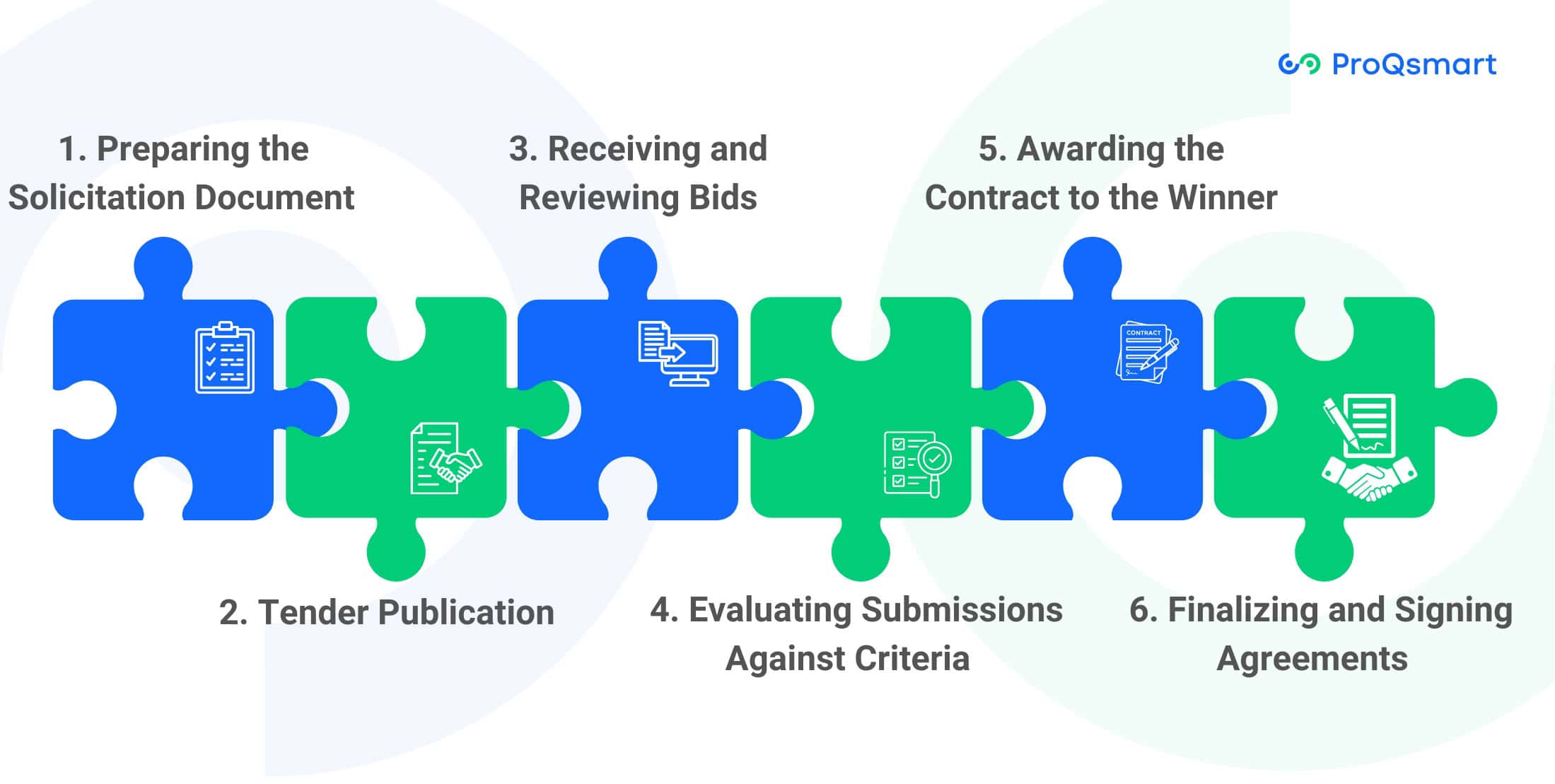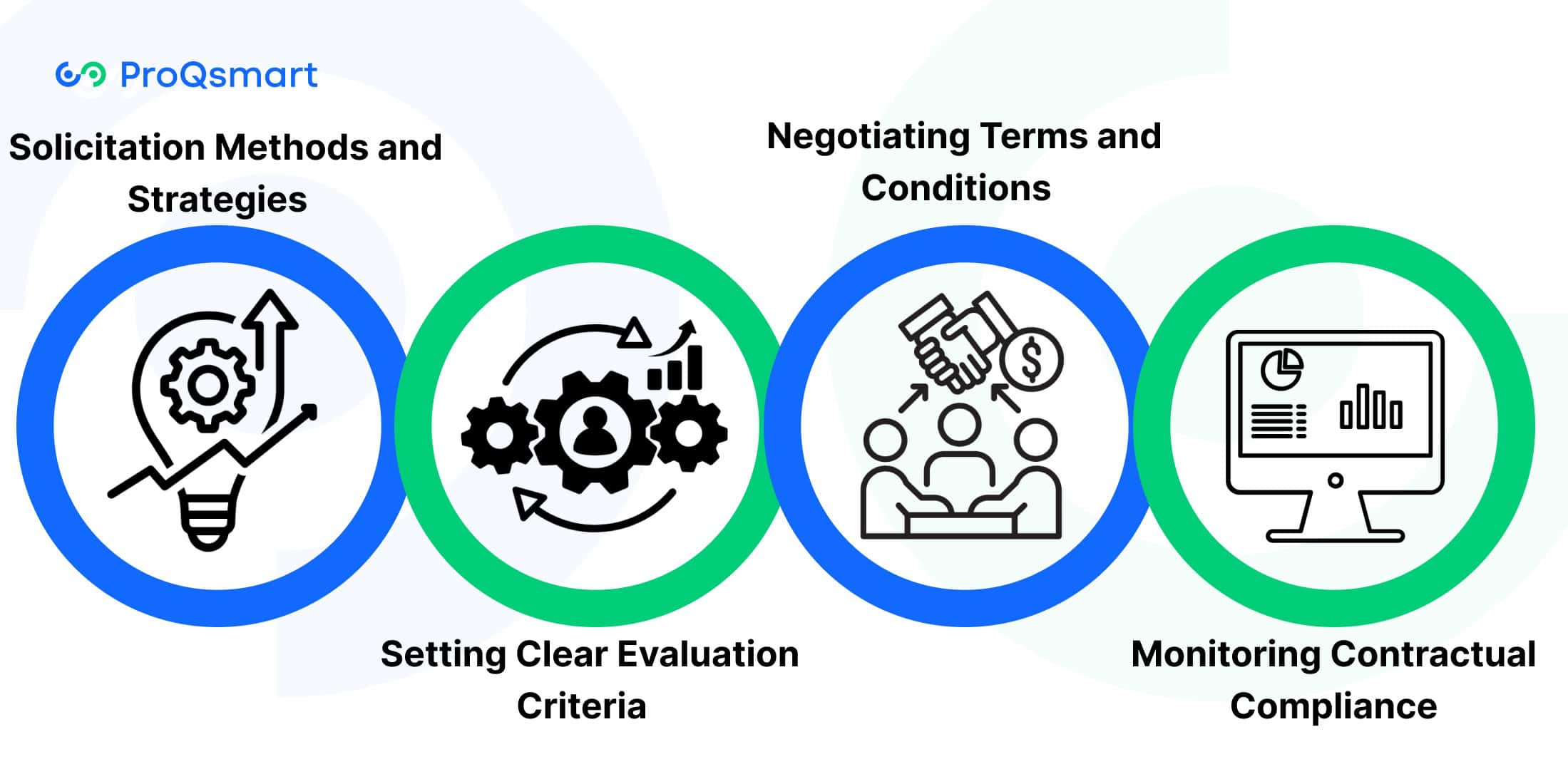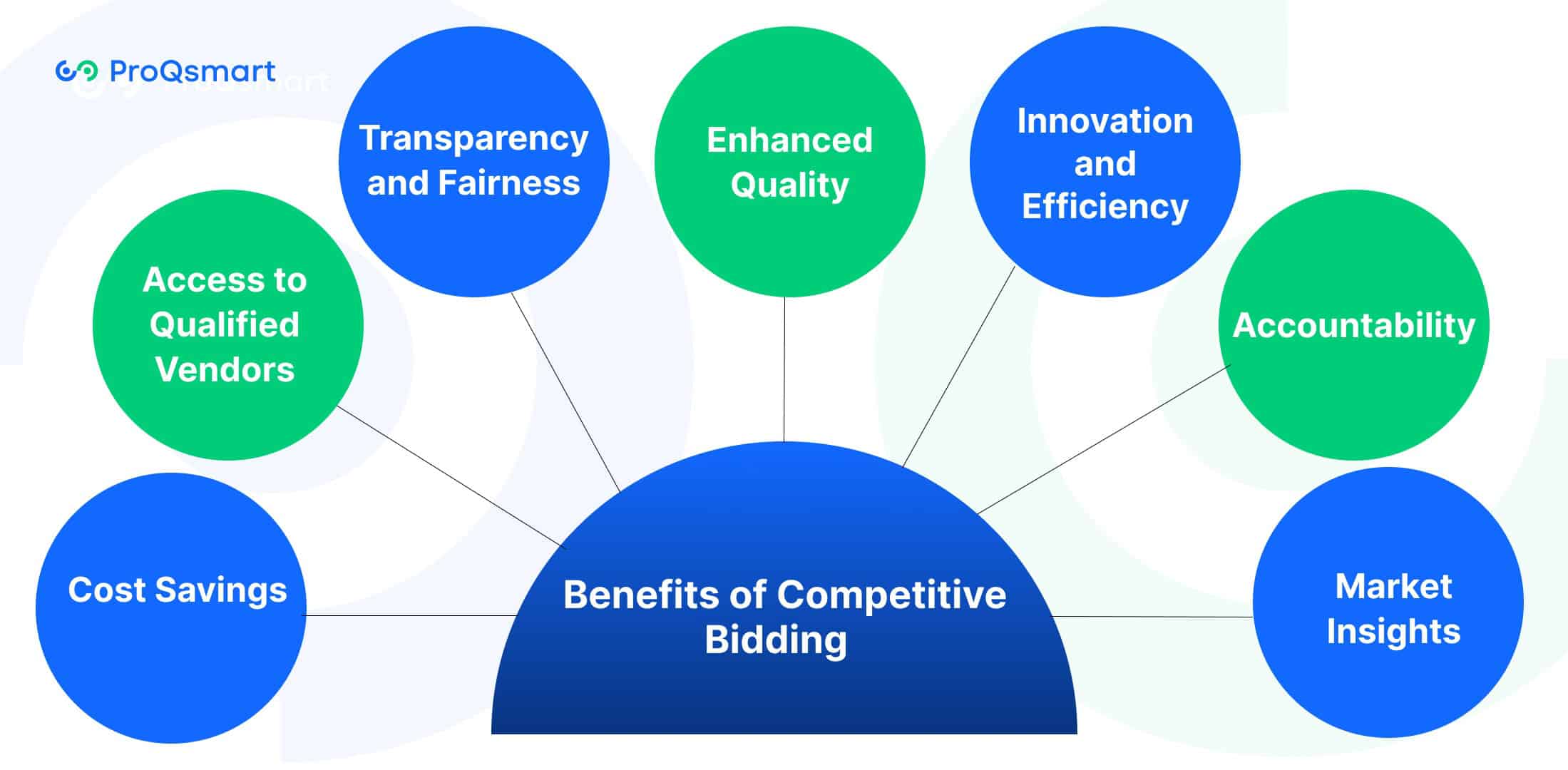Competitive bidding is an essential component of procurement process, helping organizations get more cost-effective solutions without sacrificing quality or compliance. Conduct a competitive bidding process by taking bids from several providers. This gives procurement professionals the flexibility to make decisions based on price, service, and other essential factors.
This approach encourages transparency, builds competitive bidding, and allows companies to get the most value for their dollars. By taking advantage of competitive bidding, firms can avoid budget limitations, lower procurement risk, and establish dependable networks of suppliers.
For procurement professionals trying to navigate the new world of competitive sourcing, it is crucial to understand the principles and competitive bidding strategies that underlie competitive bidding. This process increases operational efficiency.
Moreover, it underpins longer-term objectives of sustainability and smart growth, further establishing it as a cornerstone to contemporary procurement practices.
What Is Competitive Bidding?
Competitive bidding is a structured procurement process where organizations solicit proposals from multiple suppliers or service providers to fulfill their needs. This method fosters a competitive environment, ensuring that the procurement process is transparent and equitable. By utilizing competitive bidding programs, companies can enhance their chances of receiving quality offers from various contract suppliers.
In this process, companies create formal solicitation documents, such as Requests for Proposals (RFPs) or Requests for Quotations (RFQs), which outline specific requirements and evaluation criteria. By inviting bids, organizations can compare offers based on established standards, such as cost, quality, and delivery timelines. This comparison is crucial for potential buyers looking to identify the best competitive bid contract.
For instance, in the construction industry, if a company requires specific materials for a project, it will issue a bid invitation to suppliers. This allows vendors to compete openly, ensuring equal opportunities for all eligible participants. Ultimately, the organization can select the best proposal that aligns with its objectives, potentially leading to successful contract awards.
Competitive bidding not only enhances accountability by providing a standardized framework for evaluation but also promotes fairness and inclusion among suppliers. This approach enables buyers to make informed decisions that optimize value while fostering a healthy competitive marketplace.
Purpose of Competitive Bidding in Procurement Processes
The main intent behind competitive bidding is to ensure that public entities are getting the best value for their buck. For buyers, it guarantees that the buyer will not overpay by incentivizing low-priced, competitive offers. Procurement solicitors will often have internal departments or use external consultants to manage the process, ensuring proper evaluation.
More importantly than saving money, competitive bidding encourages informed decision-making. By requesting more comprehensive proposals, buyers can better evaluate which vendor will work most closely with them to achieve their goals. Sellers, by contrast, are incentivized to first and foremost meet the buyer’s specific needs in the most compelling way possible.
Importance of Competitive Bidding for Buyers and Sellers
For purchasers, competitive bidding provides the greatest choice and flexibility, allowing them to choose the best product and service that meets their unique needs. It fosters public confidence in procurement since the process is clearly defined and fair.
Sellers, for their part, win by receiving an online storefront for their products. For small businesses and nonprofits, competitive bidding can be a pathway to new markets and long-term partnerships.
Key Steps in the Bidding Process

1. Preparing the Solicitation Document
The solicitation document set the tone and tenor for the entire competitive bidding process. It should spell out
The project scope
Anticipated deliverables
Timelines
Qualifications desired from Vendors.
Specific elements to include are well-defined technical requirements, clear proposal evaluation criteria, and explicit proposal submission instructions.
For example, in construction design-build projects, the agreement often outlines material specifications or design requirements that meet safety standards. Clarity in these areas minimizes confusion, making it clear to bidders what will be expected of them. Adherence to legal and regulatory requirements is paramount.
2. Advertising the Bid Opportunity
To effectively advertise bid opportunities, it’s essential to reach the right vendors.
For example, in construction, open tendering typically relies on broad advertising to engage a larger audience of contractors, while negotiated tendering may focus on direct invitations to select contractors known for their expertise. By leveraging smart advertising strategies across various procurement software like ProQsmart, construction companies can increase interest from qualified contractors and ultimately enhance the competitive nature and quality of their bids.
3. Receiving and Reviewing Bids
Setting up secure protocols for receiving bids is critical and cannot be compromised to ensure bidder confidentiality and protect against bid tampering. For instance, the use of sealed envelopes or encrypted digital submissions. By documenting the entire process—from the time stamp of submission to receipt confirmation—there is clear accountability.
A formal review process, including the establishment of a review panel, helps provide uniformity when weighing bids against each other. This process helps ensure the balance between fairness and efficiency.
4. Evaluating Submissions Against Criteria
Criteria | Description |
Price Competitiveness | Ensures the bid aligns with budget expectations. |
Vendor Experience | Assesses past performance and expertise in similar projects. |
Technical Compliance | Confirms adherence to project specifications and requirements. |
Delivery Timeline | Evaluates the proposed schedule for project completion. |
Sustainability | Considers eco-friendly practices or materials in the bid proposal. |
Careful scoring based on these criteria informs decision making, ensuring that whatever competitive bid contract is chosen represents the best value.
5. Awarding the Contract to the Winner
Once the evaluation process is complete, the contract is awarded to the most qualified bidder. For example,in construction industry, general contractors (GCs) often compile proposals from subcontractors to create their final bid, ensuring that it aligns with the project’s scope and requirements.
This competitive process emphasizes the importance of thorough evaluation and selection, as it helps ensure that the chosen vendor can deliver the best value and meet project expectations effectively.
6. Finalizing and Signing Agreements
Finalization is about honing in on specific terms, clarifying any uncertainties, and establishing agreement from all parties. This stage usually involves an extensive legal review and collecting signatures, formalizing the partnership.
Well-defined agreements set the stage for successful project delivery.
Essential Components of Competitive Bidding

Solicitation Methods and Strategies
The very first functional step of competitive bidding starts with choosing the right solicitation strategy. Select the most appropriate format for your audience. Be it RFP, RFI or RFQ, depends on the type and complexity of your need.
For example, RFPs work best for complex projects needing nuanced solutions, whereas RFQs fit simple, transactional purchases. Sellers need to deeply understand buyer requirements in order to develop offers that meet expectations.
This should involve pricing approaches that are based on the best possible cost estimates while being competitive in the market. Cost is still key. Though now more than ever, cost estimation is critical to winning the contract.
The use of competitive bidding goes beyond the procurement of goods and services, with the practice even becoming applicable in cases such as Initial Public Offerings (IPOs).
Setting Clear Evaluation Criteria
Evaluation criteria should serve as the baseline for assessing bids in the construction or manufacturing industries. Buyers typically select the lowest responsive and responsible bidder for fixed-price contracts, but other factors may also influence the decision, such as supplier reliability or the concentration of annual spending with a particular vendor.
For example, in the construction industry, competitive bidding may be bypassed for projects if a significant portion of the total spend—say, a substantial percentage—is allocated to one contractor. This allows for streamlined procurement processes when dealing with established suppliers who have consistently demonstrated their capability and reliability. By focusing on these evaluation criteria, organizations can ensure they are selecting the most qualified bidders while maintaining efficiency in their procurement practices.
Negotiating Terms and Conditions
Once a bidder is selected, negotiating the contract terms is essential to ensure alignment with project goals. This involves clarifying deliverables, timelines, and payment structures to avoid any misunderstandings. In cases of competitive bidding programs, where only one supplier meets the project’s requirements, it becomes even more critical to engage in detailed negotiations. This helps justify the lack of competition and ensures that all parties are on the same page regarding expectations and obligations.
Monitoring Contractual Compliance
Monitoring contractual compliance extends beyond the initial award of the contract terms. Ongoing oversight is essential to ensure adherence to the agreed-upon terms and relevant regulatory guidelines. Implementing policies, such as supplier diversity initiatives, helps maintain compliance and uphold the integrity of competitive bidding programs. Regular reviews and assessments of contract performance are crucial for identifying any deviations from expectations and addressing them promptly. This proactive approach fosters accountability and ensures that all parties fulfill their obligations throughout the contract lifecycle.
Benefits of Competitive Bidding

Competitive bidding programs offer several advantages for both buyers and sellers in the procurement process, enhancing the bidding requirements.
Cost Savings: First and foremost, inviting multiple vendors to submit bids allows organizations to compare prices. This competition encourages suppliers to offer their best pricing, which can lead to significant savings.
Access to Qualified Vendors: Additionally, the competitive bidding process helps identify the most qualified suppliers for goods and services. Buyers can evaluate proposals based on specific criteria, ensuring they work with experienced and capable vendors.
Transparency and Fairness: Moreover, competitive bidding promotes transparency in the procurement process. This reduces the risk of favoritism or bias, as clear rules and criteria ensure that all suppliers have an equal chance to compete for contracts.
Enhanced Quality: Furthermore, with multiple vendors vying for a contract, there is a strong incentive for them to improve their offerings. This competition can lead to higher quality products and services as suppliers strive to stand out.
Innovation and Efficiency: In addition, competitive bidding encourages suppliers to innovate and find more efficient ways to deliver their products or services. This drive for improvement can result in better solutions that meet the buyer’s needs.
Accountability: Another important benefit is that the structured nature of competitive bidding holds suppliers accountable for their proposals. Clear evaluation criteria help ensure that selected vendors meet their commitments throughout the contract duration.
Market Insights: Finally, engaging in competitive bidding provides buyers with valuable insights into market conditions, pricing trends, and supplier capabilities. This information helps them make informed procurement decisions.
Challenges in Competitive Bidding
Risk of Supplier Collusion: Suppliers may secretly agree to fix their bids, leading to inflated costs and reduced competition. This undermines the integrity of the bidding process.
Time-Intensive Preparation and Review: The preparation and review phases can be lengthy and resource-intensive, making it challenging for procurement teams to establish target prices and analyze market trends efficiently.
Managing Conflicts of Interest: Personal relationships or biases can interfere with the fair selection of vendors, potentially compromising the integrity of the procurement process.
Ensuring Bidder Compliance: Bidders must follow strict guidelines regarding cost estimates and delivery schedules. Failure to do so can result in unrealistic bids and project delays.
Lack of Transparency: Insufficient transparency in the bidding process can lead to mistrust among suppliers and stakeholders, making it difficult to ensure a fair competition.
Difficulty in Evaluating Proposals: With multiple bids to assess, procurement teams may struggle to evaluate proposals objectively, especially when criteria are not clearly defined.
Market Fluctuations: Changes in market conditions can affect pricing and availability, complicating the bidding process and potentially leading to challenges in fulfilling contract terms.
Strategies to Overcome Challenges
Implementing Rigorous Oversight Mechanisms
To maintain the integrity of the competitive bidding process, it is essential to implement effective oversight at every stage. Establishing clear expectations and evaluation criteria from the beginning helps avoid ambiguities that can lead to conflicts.
Using a Guaranteed Maximum Price (GMP) contract offers cost certainty for project owners and shifts cost control responsibilities to contractors, reducing financial risk. Additionally, involving a construction management team early on allows for the proactive identification and mitigation of potential risks, helping ensure projects are completed on time or under budget.
Adopting a serial tendering approach can further enhance accountability, particularly for large-scale projects like new residential developments. This method streamlines processes and increases accuracy through repetitive workflows. By implementing these strategies, organizations can effectively navigate challenges in competitive bidding and achieve successful project outcomes.
Streamlining Bid Evaluation Processes
An effective bid evaluation process is crucial for minimizing delays in contract awards and ensuring objective decision-making. By utilizing detailed cost modeling, organizations can uncover hidden savings opportunities that enhance procurement efficiency.
Implementing a structured evaluation framework allows for comprehensive analysis of bids, ensuring fair consideration of all factors. Additionally, fostering collaboration among stakeholders improves communication and leads to better project outcomes.
These strategies highlight the importance of a tailored evaluation framework that meets the unique needs of each project. By focusing on these principles, organizations can streamline their bid evaluation processes, resulting in timely awards and increased overall value.
Encouraging Open Communication with Vendors
Being transparent in your communication goes a long way in building trust and developing strong relationships with vendors. Having an open discussion around expectations, timelines, and budgets keeps everyone on the same page and helps avoid assumptions that lead to miscommunication.
Including regular feedback mechanisms builds capacity on both sides and enables vendors to improve their subsequent proposals, creating better results for all. For example, lean methodologies have been successful at improving coordination between construction crews, helping projects run much more seamlessly.
Leveraging Technology for Bid Management
When you adopt digital tools, you make the complicated process of managing a bid much easier. Platforms built for RFP (Request for Proposal) management simplify document organization. They increase accuracy, which is important since the average RFP win rate is just 44%.
Tools like ProQsmart are built to support advanced analytics, empowering procurement teams to spot valuable trends and make smarter decisions. In construction, when technology is associated to lean practices, it improves flow almost as much as it improves communication.
Housing developers operating large, multi-year projects are seeing an opportunity in digital solutions. This central coordination of serial tendering strengthens the culture of consistent processes and improves project oversight.
Buyer Perspectives on Competitive Bidding
Enhanced Competition: Competitive bidding attracts a larger pool of qualified suppliers, increasing competition and leading to better pricing and value.
Speed of Transactions: The process accelerates sales cycles, allowing buyers to finalize transactions quickly and reduce carrying costs, such as taxes and maintenance.
Predictability: Establishing firm deadlines for bids removes uncertainty, simplifying planning and scheduling while eliminating extended negotiations.
Flexibility in Auction Formats: Buyers can choose from various auction formats, such as open or sealed bids, to suit their preferences and needs.
Desire for Expertise: Many buyers prefer working with agents experienced in competitive bidding, emphasizing the importance of expertise in navigating the process.
Transparency and Fairness: Competitive bidding ensures equal access for all participants, fostering trust and leading to more equitable outcomes.
By leveraging these benefits, buyers can optimize their procurement strategies through competitive bidding programs.
Seller Perspectives on Competitive Bidding
Structured Sales Process: Competitive bidding offers sellers an organized and efficient way to meet their sales objectives.
Flexible Sale Timing: Sellers can choose their auction dates, allowing them to align sales with production schedules or cash flow needs.
Strategic Scheduling: Timing auctions during high-demand periods attracts more bidders and can lead to better sale outcomes.
Diverse Auction Formats: Sellers have the option to select from various auction formats, such as time-limited or no-haggle auctions, each with its own advantages.
Faster Sales and Lower Costs: Competitive bidding often results in quicker transactions, enabling sellers to close deals in less than 30 days and reduce carrying costs.
Reduced Showings: The bidding process minimizes the need for repeated property showings, saving sellers time and effort.
Higher Sale Prices: Increased competition among buyers typically drives sale prices above market averages, maximizing returns for sellers.
By utilizing these advantages, sellers can effectively enhance their sales strategies through competitive bidding programs.
Identifying Qualified Vendors
Assessing Vendor Experience and Expertise
Evaluating a vendor’s experience and expertise is a crucial first step in competitive bidding. By focusing on their track record, businesses can identify vendors who align with specific project needs. For instance, manufacturers with prior success producing similar components or products demonstrate an understanding of relevant material specifications and quality control requirements.
Reviewing case studies, client testimonials, and references can provide clear insights into their capabilities. Assessing certifications or industry affiliations can further validate their qualifications. By streamlining this process, you can save valuable time selecting a qualified vendor.
Sometimes going from months to just days. For instance in construction industry, if a specialized contractor with proprietary technology for tunnel boring is to be procured via sole-source, justification needs to fit an approved criterion, such as the unique nature of their expertise. This ensures a transparent and efficient process while complying with safety and environmental regulations.
Verifying Financial Stability and Reliability
Verifying the financial stability and reliability of a vendor is essential to ensure they can fulfill their commitments. One effective approach is to review the vendor’s financial statements, including income statements, balance sheets, and cash flow statements, which provide insights into their profitability, liquidity, and overall financial health.
Additionally, checking the vendor’s credit rating from reputable sources can indicate their risk level; a high credit score typically reflects a lower likelihood of default. Analyzing the vendor’s performance history through references and testimonials helps assess their reliability and quality of service. If feasible, conducting site visits to inspect the vendor’s facilities can offer valuable firsthand insights into their operations and capacity. It’s also important to evaluate debt levels by examining metrics such as the debt-to-equity ratio, as high levels of debt may signal potential financial risk.
By implementing these practices, organizations can make informed decisions when selecting vendors, ensuring they engage with financially stable and reliable partners.
Conclusion
Real competitive bidding is a powerful mechanism that directly promotes value, efficiency, and fairness in procurement. It enables organizations to secure the best possible deals while maintaining transparency and fostering strong vendor relationships. To maximize the benefits of competitive bidding, it’s essential to approach it with a clear plan and defined objectives. Thoughtful strategies can help navigate complexities, ensuring positive outcomes while minimizing potential drawbacks.
For buyers, competitive bidding translates into cost savings, improved quality, and reduced risk. Sellers benefit by gaining access to new markets and enhancing their credibility, as they must demonstrate their value through competition. Success in this environment relies on clear communication, thorough research, and effective teamwork. Identifying the most qualified vendors is a critical step toward achieving optimal results.
Ultimately, effective procurement is grounded in knowledge and foresight, coupled with purposeful engagement. By continuously refining your processes and remaining adaptable, you can leverage the power of competitive bidding to achieve your goals.
To enhance your procurement strategy further, consider utilizing ProQsmart, a comprehensive platform designed to streamline the bidding process and improve outcomes. Book a demo today to discover how ProQsmart can help you create a smarter, more effective procurement process that drives success for your organization.



